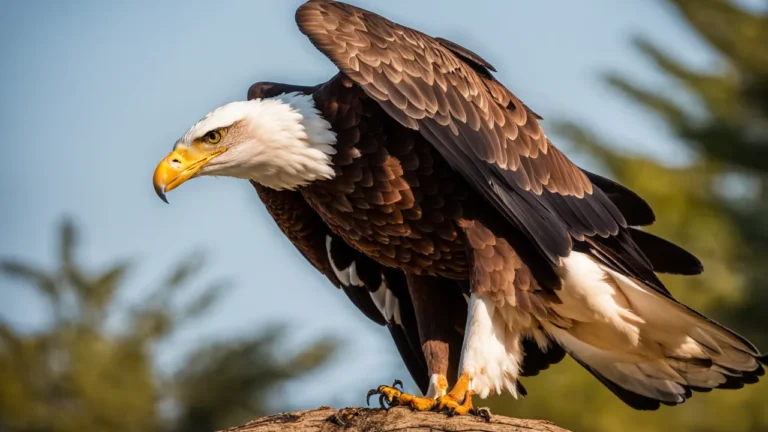The fish eagle and the bald eagle are two of the most magnificent apex predators in the avian world, inspiring awe with their massive, unique frames and formidable hunting skills. For those with limited time, the following is a brief response to your inquiry: The physical characteristics, habitats, food, breeding patterns, and conservation status of the African fish eagle and the North American bald eagle vary significantly, despite some similarities.
We will carefully examine and contrast the fish eagle and the bald eagle in this text, which is nearly three thousand words long. We will emphasize the distinctive characteristics and lifestyles of each species by carefully examining their morphology, geographic ranges, feeding ecology, reproductive tactics, and population trends.
These formidable raptors, who may be seen diving for fish or fly high in the sky, embody the royal majesty of birds of prey.
Differentiating Physical Features
The differences between the Fish Eagle and the Bald Eagle’s physical attributes become clear when comparing them. Let’s examine their dimensions, wingspan, coloring, legs, beaks, and talons in more detail.
Dimensions and Spread of Wings
The African Fish Eagle, sometimes referred to as the Fish Eagle, is somewhat smaller than the Bald Eagle. The Fish Eagle has an estimated length of 2.3 feet (70 cm) and a wingspan of 6.6 feet (2 meters) on average.
By contrast, the Bald Eagle is bigger, growing to a length of around 2.5 feet (76 cm) and a wingspan of up to 7.5 feet (2.3 meters).
Patterns of Color
The two eagles’ color patterns are among their most noticeable distinctions. The Fish Eagle is mostly brown in appearance, with a white head and tail. Its breast is uniquely colored either black or dark brown.
The Bald Eagle, on the other hand, has a remarkable contrast between its white head, white tail, and dark brown body plumage. What distinguishes and gives the Bald Eagle its distinctive look is its unique white-feathered head.
Beaks, Talons, and Legs
Strong and powerful legs, beaks, and talons are characteristics shared by both the Bald Eagle and the Fish Eagle, which are necessary for their hunting and eating habits. The Fish Eagle can precisely capture fish from the water’s surface because to its long, powerful legs and its keen, curved talons.
It can grasp and rip apart its prey because to its enormous, hooked beak. Similar to this, the Bald Eagle is a dangerous predator thanks to its strong legs, keen talons, and hooked beak.
You may visit National Geographic and Audubon for further details on the physical traits of the Bald and Fish eagles.
Habitats and Regional Distributions
Eagle Territory Fish
The sub-Saharan African region is home to the Fish Eagle, also called the African Fish Eagle, which lives in a range of aquatic habitats such marshes, rivers, and lakes. It is possible to see this magnificent bird in South Africa, Zambia, Kenya, and Botswana.
The Fish Eagle, with its eye-catching brown feathers and unique white head, is well-known for its outstanding hunting prowess and capacity to grab fish with its keen claws out of the water. Given that it depends on water sources for both feeding and nesting, its preferred habitat is directly correlated with their availability.
Territory of Bald Eagles
The Bald Eagle, on the other hand, is mostly found in North America, more precisely in the US and Canada. The spectacular vistas of Alaska and the Pacific Northwest are often linked with the Bald Eagle, which is recognized for its distinctive white head and tail feathers.
It is, nonetheless, also present in other sections of the continent, such as the Mississippi River basin and the Great Lakes region. Because it depends on these habitats for its main food supply, fish, the Bald Eagle prefers a combination of coastal regions, lakes, rivers, and woods.
Visit https://www.audubon.org/field-guide/bird/african-fish-eagle for further details on the Fish Eagle’s range.
You may visit https://www.nationalgeographic.com/animals/birds/facts/bald-eagle for additional details on the Bald Eagle’s range.
Fish-Based Diets and Fish-Hunting Eagles: Fish Dependency
As their name implies, fish eagles are very skilled at locating and devouring fish. They have many distinct hunting strategies and are well-suited to their watery existence. Because they can readily see their food near bodies of water like rivers, lakes, and coastal regions, these magnificent birds are often seen in close proximity to them.
Fish eagles’ airborne plunge-diving technique is one of their most amazing hunting strategies. They fly at great heights above the sea before making an abrupt, very precise plunge, utilizing their keen talons to grab fish off the surface.
This ability calls for extraordinary coordination and vision. Fish eagles are very proficient hunters since they can bring down prey weighing as much as four to five pounds.
Fish eagles are also well-known for their capacity to pilfer fish from other avian predators, such pelicans and ospreys. When it comes to scrounging for food, they can be quite crafty. Rather of using their energy to capture their own fish, they wait patiently for a chance to pilfer from other birds, diving in at the perfect time to snag the fish midair.
They are known as the “pirates of the sky” as a result of their actions.
Bald Eagles: Feeding Opportunistically
Conversely, bald eagles are recognized for their sly eating practices. They do not only eat fish, even though it is their primary source of nutrition. These predatory birds adjust their hunting tactics according on the availability of prey and have a varied diet.
Being expert hunters, bald eagles may capture a wide range of prey, such as animals, birds, reptiles, and even carrion. They are renowned for their breathtaking aerial performances, when they fly through the skies and use their acute vision to identify possible prey from a distance.
When they have found their prey, they descend with amazing speed and extend their talons to seize it.
Bald eagles, in contrast to fish eagles, are opportunistic scavengers that will not turn down the opportunity to eat carrion. They have been seen taking food from other birds, smaller bald eagles and ospreys, among others.
They may take advantage of a simple meal thanks to this behavior, which eliminates the need for intensive hunting.
Were you aware? With a wingspan of up to seven feet, bald eagles can fly across the sky with ease. They are renowned for having extraordinary strength and dexterity, which makes them fierce hunters.
Fish Eagle Reproduction and Breeding Fish Eagle Nests and Young
The Fish Eagle’s mechanism of reproduction and breeding is really intriguing. High up in towering trees close to sources of water, like rivers or lakes, these magnificent birds construct enormous nests constructed of twigs and branches.
The eagles may add additional material to their nests over time, causing them to expand in size and be reused often. One to three eggs are laid in the nest by the female Fish Eagle, and both parents incubate them for forty to forty-five days.
The baby eaglets are entirely reliant on their parents for food and protection once the eggs hatch, and they are coated with soft down. To satisfy their children’s hunger, the parents alternately go hunting and return back fish.
The eaglets grow until they have the distinctive white head and tail feathers, which show completely after four or five years. Watching the baby Fish Eagles stretch their wings and fly over the sky on their maiden flights out of the nest is an amazing sight.
Baby Eagles and Bald Eagle Nests
The national bird of the United States, the Bald Eagle, has distinct breeding and reproductive habits of its own. These amazing birds construct enormous nests, known as aeries, that may weigh up to a ton and have a circumference of up to ten feet.
The aeries provide the eagles a safe and elevated place to raise their young since they are constructed high up in tall trees or on cliffs close to bodies of water.
Like the Fish Eagle, the female Bald Eagle lays one to three eggs, which are then incubated for about 35 days by each parent alternately. The baby eaglets are coated in a covering of light gray down as soon as the eggs hatch.
Seabirds are very protective of their young, feeding them mostly fish and shielding them from other predators. The distinctive white head and tail feathers of the eaglets develop as they grow, reaching full maturity at the age of four to five.
Reproduction and breeding are essential parts of this spectacular predator’s life cycle. We can better understand the commitment and tenacity of these amazing animals when we comprehend the subtleties of their nesting behaviors and the care they provide to their young.
Threats and the State of Conservation
Fish Eagles: Consistent Numbers
Fish eagles, also referred to as ospreys, are magnificent raptors that live in many parts of the world. Because of effective conservation efforts, the numbers of these amazing species have remained constant.
Their capacity to adapt to many environments, such as lakes, rivers, and coastal regions, is one of the factors contributing to their steady population levels. Their booming numbers have also been facilitated by the abundance of fish, which provides a substantial amount of their food, and the availability of good nesting places.
Fish eagles are still in need of protection from specific risks despite their generally stable situation. The loss of habitat brought on by industrial expansion and urbanization is one of the major issues. Fish population declines and the availability of appropriate nesting places are directly impacted by the degradation of wetlands and pollution of water bodies.
These birds and their habitats are also under danger due to climate change, which brings with it unpredictable weather patterns and increasing sea levels.
Fish eagles are under constant threat, and conservation groups and wildlife officials are working nonstop to lessen these dangers. The creation of protected areas, the rehabilitation of wetlands, and the adoption of sustainable fishing methods are among the initiatives.
The goal of these actions is to guarantee the survival of fish eagles and their essential function in preserving environmental equilibrium.
Bald Eagles: Recuperated from Peril
Compared to fish eagles, the famous American national bird, the bald eagle, has had a distinct conservation path. Bald eagles, which were once in danger of becoming extinct, have recovered remarkably and are no longer considered an endangered species.
This amazing success story demonstrates the value of legislative safeguards and the efficacy of conservation initiatives.
Bald eagles have historically been threatened by a variety of factors, such as habitat loss, poaching, and the use of pesticides like DDT, which thins their eggshells. Their numbers significantly declined as a result of these conditions, which prompted environmentalists to intervene.
The bald eagle’s comeback was greatly aided by the prohibition of DDT, the preservation of nesting locations, and the implementation of stringent hunting laws.
Thousands of nesting pairs of bald eagles may be found all throughout the United States nowadays, as the species’ population has considerably recovered. They have recovered so well that the list of endangered species was withdrawn in 2007.
This does not, however, imply that their conservation adventure is over. To address persistent risks including pollution, habitat deterioration, and accidents with electricity lines, further work is required.
Governmental bodies, concerned people, and conservation groups are collaborating to guarantee the bald eagles’ long-term existence. There are initiatives in place to safeguard these magnificent birds and their environments, including public education campaigns, habitat restoration projects, and nest site monitoring.
Final Thoughts
Despite being the top bird predators on their respective continents, the African fish eagle and the North American bald eagle vary significantly in terms of their anatomy, habitats, feeding ecology, nesting, and conservation requirements.
Our attention is drawn to their majestic features, yet a closer examination of their lives reveals two totally different animals that are remarkably suited to their surroundings. Understanding the differences between these magnificent raptors helps us to appreciate the variety of raptors found all over the world.


![What Does “For the birds Mean”? [Explained]](https://birdsology.com/wp-content/uploads/2023/08/Flickr_-_Rainbirder_-_Yellow-billed_Oxpecker_Buphagus_africanus-600x400.jpg.webp)


![Are Dinosaurs Birds Or Reptiles? [Explained]](https://birdsology.com/wp-content/uploads/2024/01/14628.webp-600x400.webp)